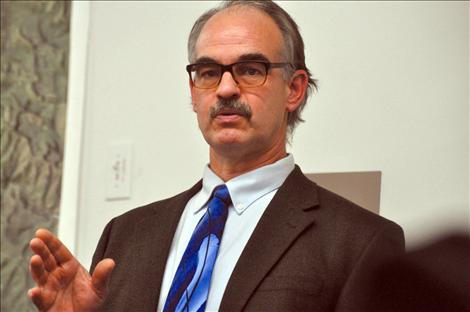Consultant details role in lawsuits, compact
Hey savvy news reader! Thanks for choosing local.
You are now reading
1 of 3 free articles.
ST. IGNATIUS – A Helena-based engineer told irrigation commissioners Nov. 12 that he believes he can provide critical insight into how the Flathead Indian Irrigation Project currently runs and could be improved, as the irrigation districts attempt to gain control of the project through lawsuit and obtain ownership of the project water right through the Confederated Salish and Kootenai Water Compact.
Ed Everaert of WWC Engineering has been on the Flathead Joint Board of Control’s payroll for several months. In that time he has testified before an interim committee of the state legislature in Helena on the board’s behalf in regards to the Confederated Salish and Kootenai Compact and has drafted testimony for a lawsuit where the irrigation districts have sued to take back local control of the project.
“I see my role as two fold,” Everaert said. “One, to provide technical advice, but also as a liaison with others who are involved. I have a very good relationship with John Tubbs, who is director of the DNRC. That helps get to a resolution if it is feasible to get there. I think the knowledge of the federal irrigation projects that I have and past experience with the compact settlements ... would help not only get a good compact, but also a settlement agreement that provides for rehabilitation and betterment of this project. Then hopefully with the knowledge we have of your project we can help with the design and construction of getting this work done.”
Everaert has supervised irrigation projects across Montana and other western states that have dealt him a mix of complicated experiences involving water compacts, endangered species management, and providing for rehabilitation of watering systems. He has intimate knowledge of the problems facing the Flathead Indian Irrigation Project because he was involved in evaluating the system a decade ago for the DOWL HKM firm that came up with the operations manual and other governing documents for the Cooperative Management Entity that ran the irrigation project from 2010 until early 2014.
Everaert said the irrigation project was in dire need of rehabilitation in 2004 when he evaluated it, and that he believes his firm could eventually update the water measurement system to an automated real-time data collection network that would be accessible via the Internet. He also said his firm would be adept at grant-writing initiatives that could net funds for project improvements.
Three major hurdles could stand in the way of Everaert’s vision of betterment. An ongoing lawsuit filed by the irrigation districts asks that the project be turned over to the Flathead Joint Board of Control. Additionally, the Confederated Salish and Kootenai Tribes have filed a federal suit asking that ownership of the irrigation water running through the project be declared. The proposed Confederated Salish and Kootenai Tribes Water Compact would also have a huge impact on the future of the project if passed, as the parties currently negotiating have promised to earmark funds for rehabilitation and betterment.
Everaert gave irrigation commissioners a brief critique of some elements the proposed compact that stressed the importance of verifying the Hydross modeling used as a framework for the agreement.
Everaert said he would like to see “verification of how much water it really takes to maximize your yields, looking at net irrigation requirements, instead of having a theoretical model. The Hydross model is a planning tool developed by the Bureau of Reclamation that I used for four years when I was in the planning department. It is not an operations model that can verify water rights.”
Irrigation Commissioner Ted Hein said Everaert’s presentation was chalk full of information he hadn’t known before, especially in regard to certain elements of the Cooperative Management Entity, of which Hein sat on the board.
Members of the public also were supportive of Everaert’s evaluation.
“I think you would be a great expert witness in the legislature,” John Swenson of Ronan told Everaert.
The board gave no indication of whether or not they intended to continue working with the engineer, who was hired under contract at the direction of the board’s former longtime attorney Jon Metropoulos, who resigned in early October.
















